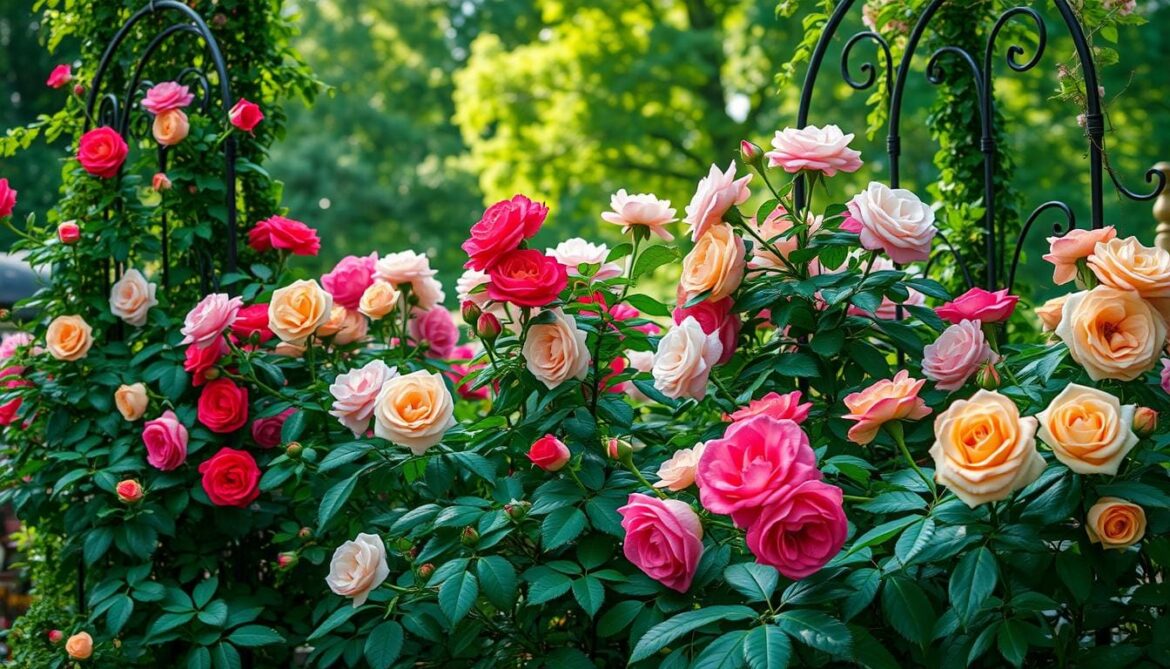Growing roses can be a joy and a challenge. But what if you could grow roses that need less care and fight off diseases? Disease-resistant climbing roses are the answer. They make any outdoor area look like a paradise.
In our garden, we’ve seen the magic of these climbing roses. Their leaves and flowers spill over trellises and fences. Roses like ‘The Generous Gardener’ and ‘Claire Austin’ have become our garden’s stars.
Key Takeaways
- Disease-resistant climbing roses are hardy, low-maintenance varieties that thrive with minimal care.
- These roses offer a diverse range of colors, fragrances, and bloom types to suit any garden style.
- Many disease-resistant climbing roses are repeat-flowering, providing a consistent display of beauty throughout the season.
- Climbing roses can be grown on a variety of structures, adding vertical interest and charm to any outdoor space.
- Disease-resistant varieties like ‘Claire Austin’ and ‘The Generous Gardener’ are highly regarded for their resilience and performance.
What Are Disease Resistant Climbing Roses?
Disease-tolerant rose climbers, also known as sustainable climbing roses, are special roses. They are bred to fight off common rose diseases. These roses grow well, bloom again, and need less care than regular roses.
They are perfect for gardeners who want beautiful roses with less work. No need for lots of care or chemicals.
Definition and Characteristics
Disease-resistant climbing roses fight off diseases like black spot and powdery mildew. They are strong and smell great, coming in many colors. These roses can grow well in different places and soils.
Importance for Gardeners
Disease-tolerant rose climbers are a big help for gardeners. They are tough and easy to care for. This means gardeners can enjoy roses without the stress of fighting pests and diseases.
By picking these roses, gardeners can make their gardens look amazing. They use less chemicals and spend less time on rose care.
“The introduction of disease-resistant climbing roses has revolutionized the way we approach rose gardening. These resilient plants allow us to create stunning displays with minimal effort, making them a true asset for any outdoor space.”
| Rose Variety | Height and Spread |
|---|---|
| ‘Charles de Mills’ | 120 x 120 cm |
| ‘Thomas á Becket’ | 100 x 120 cm |
| ‘Mortimer Sackler’ (now ‘Mary Delany’) | 360 x 130 cm |
| ‘Roseraie de L’Hay’ | 250 x 250 cm |
| ‘Boscobel’ | 90 x 75 cm |
| ‘Lady of Shalott’ | 130 x 100 cm |
Benefits of Growing Disease Resistant Climbing Roses
Gardeners looking for easy-to-care-for plants will love disease-resistant climbing roses. These plants are great for gardens in the United States. They need less care and look beautiful for longer.
Low Maintenance Requirements
One big plus of these roses is they need fewer chemicals. They are less likely to get sick or attract pests. This means you can spend less time and money on your garden.
Enhanced Aesthetic Appeal
These roses bloom for a long time and look amazing. They come in bright colors and have a strong scent. They grow fast, covering walls and fences beautifully. Adding eco-friendly climbing roses for gardens is easy and makes your garden look great.
| Benefit | Description |
|---|---|
| Low Maintenance Requirements | Reduced need for pesticides and fungicides, creating a healthier, more natural environment |
| Enhanced Aesthetic Appeal | Long-lasting, repeated blooms throughout the season, vibrant colors, captivating fragrances, and vigorous growth |
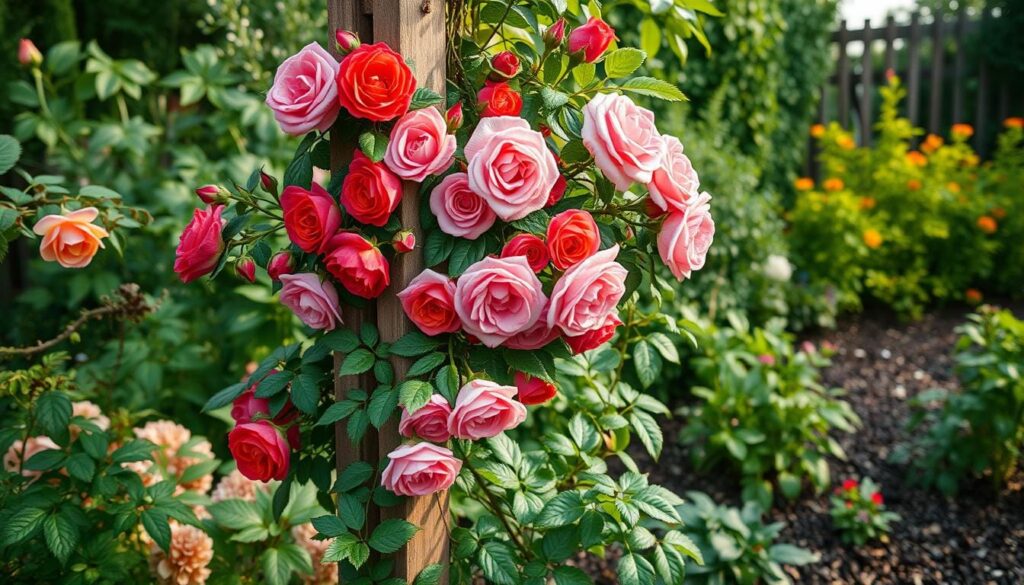
“Climbing roses are gaining popularity as cut flowers due to their lax, informal, pliable stems.”
Choosing resilient climbing rose cultivars lets gardeners create beautiful displays. It also helps support a healthy ecosystem. And, it makes enjoying the beauty of roses easy and fun.
Popular Disease Resistant Climbing Rose Varieties
There are many disease-resistant climbing roses for trellises that are both beautiful and strong. Let’s look at some top picks for gardeners to add to their landscapes.
‘New Dawn’
The ‘New Dawn’ climbing rose is known for its disease resistance. It has large, soft pink double blooms with a lovely scent. This rose grows well in many climates and is great for trellises and vertical spaces.
‘Climbing Iceberg’
The ‘Climbing Iceberg’ is a timeless choice with pure white, repeat-flowering blooms. It’s resistant to common rose diseases and has a clean look all season. Its strong climbing habit is perfect for trellises and walls.
‘Don Juan’
The ‘Don Juan’ climbing rose is known for its deep, rich color. It has large, velvety red flowers with a sweet fragrance. Its vigorous growth and repeat-flowering make it a favorite for trellises and vertical supports.
| Variety | Bloom Color | Fragrance | Disease Resistance | Growth Habit |
|---|---|---|---|---|
| ‘New Dawn’ | Soft Pink | Delightful | Excellent | Vigorous Climbing |
| ‘Climbing Iceberg’ | Pure White | Minimal | Excellent | Vigorous Climbing |
| ‘Don Juan’ | Velvety Red | Captivating | Excellent | Vigorous Climbing |
These disease-resistant climbing roses offer many options for beautiful vertical displays. Whether you prefer ‘New Dawn’s soft pink, ‘Climbing Iceberg’s classic white, or ‘Don Juan’s rich red, these roses will make any trellised garden more beautiful.
How to Choose the Right Climbing Rose for Your Garden
Choosing the right climbing roses for your garden involves several important factors. We’ll look at how to pick the best ones for your outdoor space.
Assessing Your Climate
Start by checking your local climate. Pick disease resistant climbing rose varieties that fit your hardiness zone. For example, ‘New Dawn’ climbing rose is hardy and can handle temperatures down to -20°F. It’s great for gardeners in colder areas.
Space and Support Considerations
Then, think about the space and support in your garden. Some climbing roses, like ‘Don Juan’, can grow 15-20 feet tall. Others, like ‘Climbing Iceberg’, are more compact, growing 8-10 feet tall. Make sure you have the right trellises or walls for your chosen rose.
Color and Fragrance Preferences
Lastly, pick climbing roses that match your color and fragrance preferences. You can choose from many colors, like ‘Zephirine Drouhin’s magenta-pink or ‘Eden Rose’s pink and cream. If you love fragrant roses, ‘Cécile Brünner’ is a great choice.
By considering your climate, space, and aesthetic, you can find the perfect climbing roses. They will make your garden more beautiful and charming.
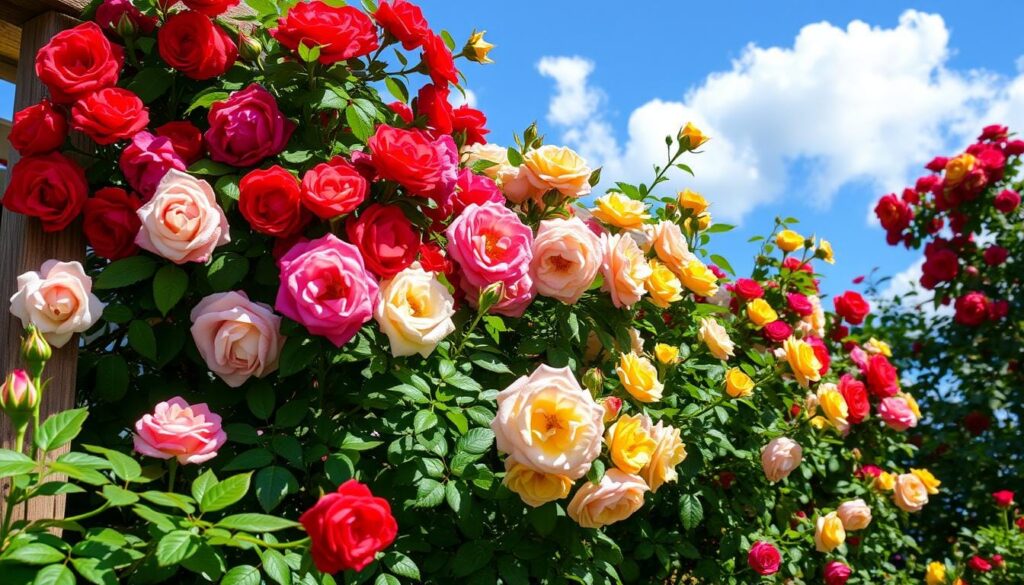
“The true secret of happiness lies in taking a genuine interest in all the details of daily life.” – William Morris
Best Soil Conditions for Climbing Roses
To grow lush climbing roses, we need the right soil. We focus on the perfect pH levels and nutrient-rich soil types. This ensures our gardens are full of healthy, sustainable climbing roses.
Ideal pH Levels
Climbing roses love slightly acidic soil, with a pH of 6.0 to 6.5. This pH helps them absorb important nutrients like iron and nitrogen. Keeping the soil at this level helps our roses grow well.
Nutrient-Rich Soil Types
Climbing roses also need soil that drains well and is full of nutrients. Adding compost or peat moss improves the soil. It feeds the plants and keeps the soil moist, preventing root rot.
| Soil Characteristic | Ideal Condition for Climbing Roses |
|---|---|
| pH Level | 6.0 – 6.5 |
| Organic Matter | High (compost, peat moss) |
| Drainage | Well-draining |
| Fertility | Nutrient-rich |
Knowing what our climbing roses need in the soil helps us create a beautiful garden. With the right soil, we get stunning blooms every season.
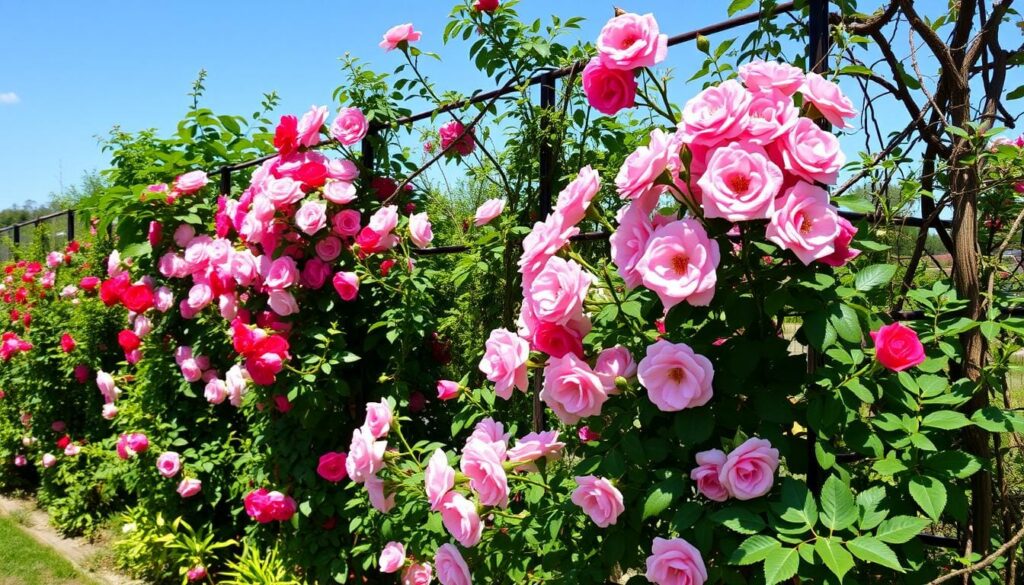
Planting Disease Resistant Climbing Roses
Adding vibrant, eco-friendly climbing roses to our gardens is exciting. Timing is crucial. For bare-root varieties, autumn is the best time. The cooler weather and moist soil help the roots grow before the growing season starts.
If you prefer potted plants, you can plant them any time of the year. This gives you more flexibility and convenience.
Step-by-Step Planting Guide
To make sure your disease-tolerant rose climbers do well, just follow these easy steps:
- Choose a healthy, disease-resistant climbing rose without damage or pests.
- Get the planting area ready by digging a hole twice as big as the root ball. Mix in organic matter to make the soil better.
- Plant the rose at the same depth it was in the pot or nursery. Make sure the graft union is 2 inches below the soil.
- Water the plant well, then add a 2-3 inch layer of mulch around it. This keeps moisture in and weeds out.
For a budget-friendly option, plant bare-root climbing roses in autumn. These dormant plants grow quickly. They also offer a wide range of disease-tolerant and eco-friendly varieties.
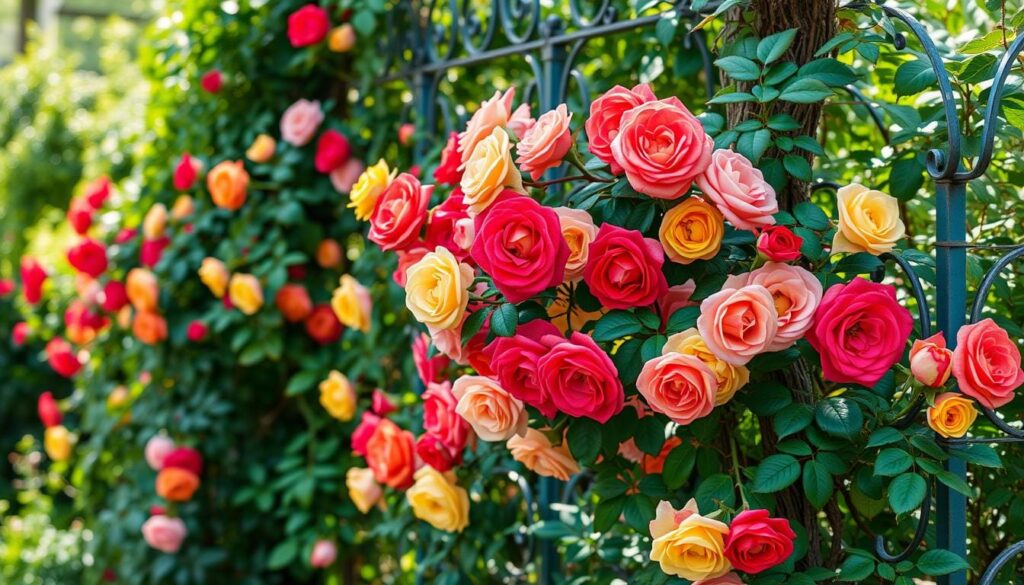
By following these simple steps, you can enjoy your disease-resistant climbing roses for years. They add beauty and are easy to care for in your garden.
Pruning Techniques for Climbing Roses
Keeping our climbing roses healthy means we need to prune them well. We should prune them in late winter or early spring, before they start growing again. This is the best time to cut out any dead, sick, or tangled branches with sharp shears.
Timing and Tools Needed
Pruning climbing roses at the right time is key. We suggest doing it in late winter or early spring, when the plant is sleeping. This helps the rose grow strong and healthy in the next season. Also, make sure your pruning tools are sharp and clean for clean cuts.
Techniques for Healthy Growth
Our goal when pruning climbing roses is to make a strong base for them to grow. Start by cutting out old, weak canes. Then, trim the good canes back to two to five buds. This helps the rose grow more flowers along the stem.
It’s also important to get rid of any suckers at the base of the plant. These suckers take energy away from the main growth. By pruning this way, our climbing roses will keep blooming beautifully in our gardens.
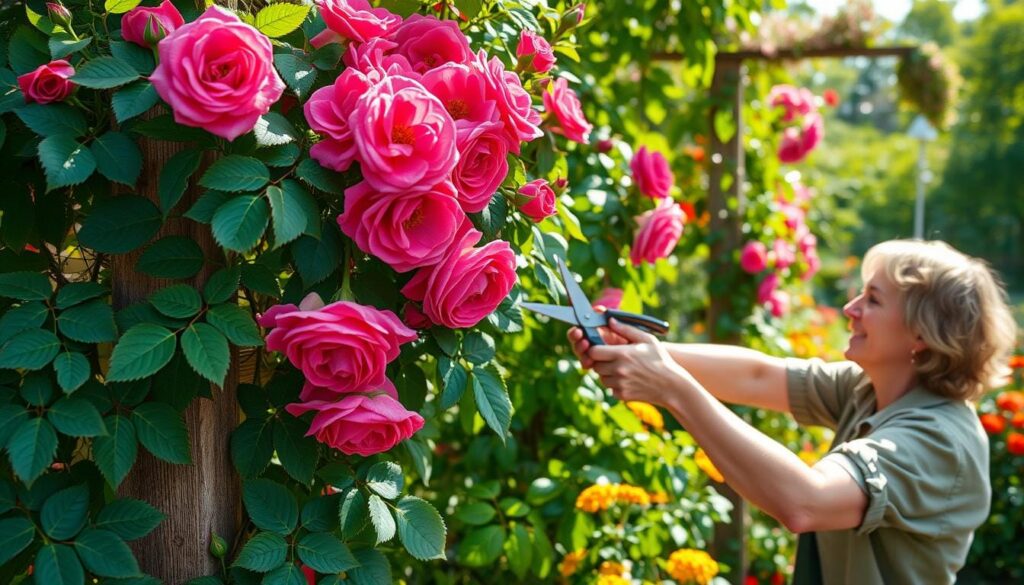
| Pruning Technique | Benefits |
|---|---|
| Remove dead, diseased, or crossing branches | Promotes healthy new growth and prevents disease spread |
| Prune back to 2-5 buds, cutting ¼ inch above the bud | Encourages lateral branching and abundant blooms |
| Train canes to grow horizontally along supports | Maximizes flower production along the entire length of the cane |
| Remove suckers from grafted roses | Prevents the plant from being overtaken by the rootstock |
By using these pruning methods, gardeners can keep their climbing roses healthy and blooming. This way, they can enjoy beautiful flowers in their gardens every season.
Fertilization Tips for Climbing Roses
To keep your climbing roses looking great, you need to fertilize them right. Knowing what they need helps them grow well all year. This way, they’ll bloom beautifully.
Best Fertilizers to Use
Start with a balanced, slow-release fertilizer in early spring. Choose one with a mix of nitrogen, phosphorus, and potassium. A ratio of 4-6-2 to 4-6-4 works well. Organic options like compost and manure also help the soil and provide nutrients.
Nutritional Needs Throughout the Year
- In early spring, use a high-nitrogen fertilizer for lots of foliage.
- After the first blooms, switch to a balanced or phosphorus-rich fertilizer for more flowers.
- As summer ends, use a slow-release or organic fertilizer to prepare for winter.
- Don’t overdo it, as too much fertilizer can harm blooms.
Adjust your fertilizing based on soil tests and your rose variety’s needs. With the right nutrients, your roses will bloom all season.
| Nutrient | Importance for Roses | Deficiency Symptoms | Excess Symptoms |
|---|---|---|---|
| Nitrogen (N) | Promotes lush foliage growth | Yellow leaves, stunted growth | Too much foliage, fewer blooms |
| Phosphorus (P) | Supports flower and root development | Leaf drop, weak flower stems | Rarely seen |
| Potassium (K) | Helps roses recover from stress | Weak flower stems, poor bud development | Rarely seen |
By following these tips, your climbing roses will get the nutrients they need. They’ll bloom beautifully all season.
Watering Guidelines for Healthy Roses
As gardeners, we know that proper watering is crucial for the health and longevity of our hardy climbing rose varieties and sustainable climbing roses. Whether you’re tending to a single climbing rose or an entire rose garden, understanding the right watering techniques can make a significant difference in the success of your plants.
Frequency and Amount
Roses, including climbing roses, generally prefer deep and infrequent watering. A good rule of thumb is to provide about 1 inch of water per week, adjusting the amount based on rainfall in your area. This deep soaking encourages the roots to grow deeper into the soil, making the plants more drought-resistant and resilient.
When watering, focus on delivering the water directly to the base of the plant, rather than wetting the foliage. This helps to prevent the development of fungal diseases that can thrive in moist conditions.
Recognizing Overwatering Signs
While it’s important to ensure our climbing roses receive adequate moisture, it’s equally crucial to avoid overwatering. Signs of overwatering can include yellowing leaves, wilting despite moist soil, and increased susceptibility to diseases. Disease-resistant varieties, such as ‘Claire Austin,’ are generally more forgiving of occasional watering inconsistencies.
To maintain the health and longevity of your climbing roses, be mindful of the water requirements and adjust your watering practices accordingly. With the right watering guidelines, you can enjoy the beauty and resilience of these stunning garden plants for years to come.
Managing Pests and Diseases
We love gardening and know that even the best climbing roses can get pests and diseases. But, with careful watching and green treatments, we can keep our disease-tolerant rose climbers and eco-friendly climbing roses for gardens looking great.
Common Pests to Watch For
Some pests that can harm climbing roses include:
- Aphids, which can quickly multiply and cause damage by sucking sap and distorting roses
- Caterpillars, which can consume rose leaves without immediate detection
- Leaf Rolling Sawfly, which injects roses with chemicals that result in curled leaves
- Red Spider Mites, which thrive in warm conditions and leave behind webbing on leaves
- Thrips, which can cause streaks in flowers and leaves, resulting in deformities
Natural Remedies and Treatments
To fight pests in a green way, we suggest:
- Encouraging natural predators like ladybugs to control aphid populations
- Using neem oil or insecticidal soaps to immobilize and eliminate pests
- Regularly hosing down plants to dislodge and discourage pests like cuckoo-spit
- Applying targeted, organic-approved sprays for severe infestations, while being mindful of beneficial insects
- Implementing physical barriers, such as wire mesh fencing, to protect roses from deer and rabbits
By being alert and using these natural solutions, we can keep pests away and keep our disease-tolerant rose climbers and eco-friendly climbing roses for gardens healthy.
| Pest | Description | Damage | Control Methods |
|---|---|---|---|
| Aphids | Soft-bodied, pear-shaped insects that suck plant sap | Distortion and stunting of new growth, secretion of honeydew | Encourage natural predators, use insecticidal soaps or neem oil |
| Caterpillars | Larvae of moths and butterflies that feed on leaves | Skeletonized or partially consumed leaves | Hand-pick, use organic Bt (Bacillus thuringiensis) sprays |
| Red Spider Mites | Tiny spider-like pests that thrive in warm, dry conditions | Webbing on leaves, discoloration, and leaf drop | Maintain high humidity, use insecticidal soaps or horticultural oils |
By knowing and tackling these pests, we can keep our disease-tolerant rose climbers and eco-friendly climbing roses for gardens healthy and strong.
Seasonal Care for Climbing Roses
As seasons change, so do the needs of our climbing roses. Let’s look at how to keep these vigorous plants thriving all year.
Spring and Summer Maintenance
In early spring, we prune and fertilize our climbing roses. This encourages growth and lots of blooms. In summer, we deadhead to keep flowers coming. We also water them about an inch a week to keep them happy in the heat.
Fall Preparation and Winter Care
In autumn, we cut back on watering and stop fertilizing. This helps them prepare for winter. Before the first frost, we mulch to keep them warm. Some, like the vigorous ‘Wollerton Old Hall’, need extra care in the growing season.
By meeting our climbing roses’ seasonal needs, they’ll keep our gardens beautiful and fragrant all year.
“Climbing roses are a true joy to grow, with their ability to transform any garden into a true haven of beauty and fragrance.”
Creating the Perfect Support Structure
When growing disease resistant climbing roses or hardy climbing rose varieties, the right support is key. These plants need strong trellises, arbors, or fences to climb and grow well.
Types of Supports
The support you choose depends on your rose variety and garden space. Here are some common options:
- Trellises: Vertical structures made of wood, metal, or vinyl. They support the climbing canes well.
- Arbors: Decorative, overhead structures that make a beautiful entrance or garden focal point.
- Sturdy fences: A solid fence can support climbing roses, especially if it’s made of durable materials.
Installation Techniques
Proper installation of your chosen support is crucial for your climbing roses’ success. Follow these tips:
- Make sure the support is firmly anchored in the ground. It should handle the weight and wind of a mature rose.
- Install the support 2 feet into the soil and 1 foot away from buildings. This ensures stability and easy maintenance.
- Use soft twist ties to attach rose canes to the trellis or arbor. Avoid weaving them through the lattice to prevent damage.
- Train the roses to grow horizontally across the support. This encourages more blooms.
By picking the right support and installing it correctly, you’ll create a great environment for your climbing roses. They’ll thrive and flourish in your garden.
Conclusion: Enjoying Disease Resistant Climbing Roses
Disease-resistant climbing roses make gardening a joy. They need little care and are good for the planet. These roses can bloom for years, adding beauty to our gardens.
Choose from roses like ‘Climbing Iceberg’ or ‘Gertrude Jekyll’ for a lovely addition. They promise to bring beauty to your garden.
Lasting Beauty in Our Gardens
These roses are not just pretty. They also add height and attract wildlife. With the right care, they become the garden’s star, blooming all season.
Their ability to fight off diseases means we get to enjoy their colors and scents easily. They’re perfect for any gardener, making gardening simple and rewarding.
Encouragement to Start Growing
Whether you’re new to gardening or have years of experience, try disease-resistant climbing roses. They’re easy to care for and can make your garden special.
Let’s enjoy the beauty and variety these roses offer. Together, we can create beautiful, sustainable gardens to be proud of.
